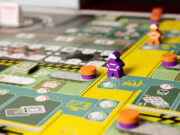 One of the great debates around the water coolers at Board Game Quest Headquarters is whether Unmatched is a skirmish or dueling card game. It’s obviously a dueling card game, thereby making our semi-fearless leader Tony Mastrangeli entirely wrong. Another, less-great water cooler debate is the difference between a trick-taking game and a ladder-climbing game. Tony is similarly wrong here as he can’t seem to get the two definitions straight. (This isn’t even a subjective conundrum like Unmatched’s status. These things have actual definitions.) Andrew Smith, BGQ editor and trick-ladder-taking-climbing aficionado, is regularly angered by these errors. It’s very amusing to those of us who, overall, don’t care one way or the other.
One of the great debates around the water coolers at Board Game Quest Headquarters is whether Unmatched is a skirmish or dueling card game. It’s obviously a dueling card game, thereby making our semi-fearless leader Tony Mastrangeli entirely wrong. Another, less-great water cooler debate is the difference between a trick-taking game and a ladder-climbing game. Tony is similarly wrong here as he can’t seem to get the two definitions straight. (This isn’t even a subjective conundrum like Unmatched’s status. These things have actual definitions.) Andrew Smith, BGQ editor and trick-ladder-taking-climbing aficionado, is regularly angered by these errors. It’s very amusing to those of us who, overall, don’t care one way or the other.
Any who, today’s review is of Reiner Knizia’s Longboard, a fast-playing ladder-climbing (trick-taking if your name is Tony Mastrangeli) game for two to four players.
Gameplay Overview:
Longboard is a ladder-climbing game in which players will be constructing surfboards along the beach in front of them. (This is called “shaping” the boards apparently and there is no beach. The beach is a lie.) To do this, players have a play area in front of them and can take one of the following actions on their turn in relation to this play area:
• Draw a card from a shared deck and add it to their personal play area (this is the surfboard parts store they own I guess?);
• Take a card they already had in their play area and either start shaping a new board with it or continue a previously started board; or
• Trade any number of cards in their play area with a different player so long as the value of the received card is less than or equal to the value of the cards given.

The catch to shaping the boards is that—like any ladder climbing game worth its salt or, in this case, beach sand—you can only play cards that are greater than or equal to the one underneath it. A board is fully shaped when it has at least four cards, at which point it will be eligible to score points equal to the number of surfboard VP stickers that appear on it (most of these are hidden during the course of the game to add a little surfing mystery to the proceedings). Any boards that aren’t finished by the game’s end will result in point deductions because surfers are very stingy in regard to how they allocate victory points.
Play continues in this way, with players adding to their play areas and boards while simultaneously “trading” (translation: stealing) cards from their opponents. The game ends once players have hit a specific condition based on how many people are in the game. (A player can end a four-player game, for instance, so long as they have at least three shaped boards with one of them containing at least seven cards.) After that, players will add up the stickers on their boards, subtract points if they failed to finish any boards, and score some extra points based on public objective cards. (These are fairly straightforward in type—“most sections of a green surfboard” and that sort of thing.)
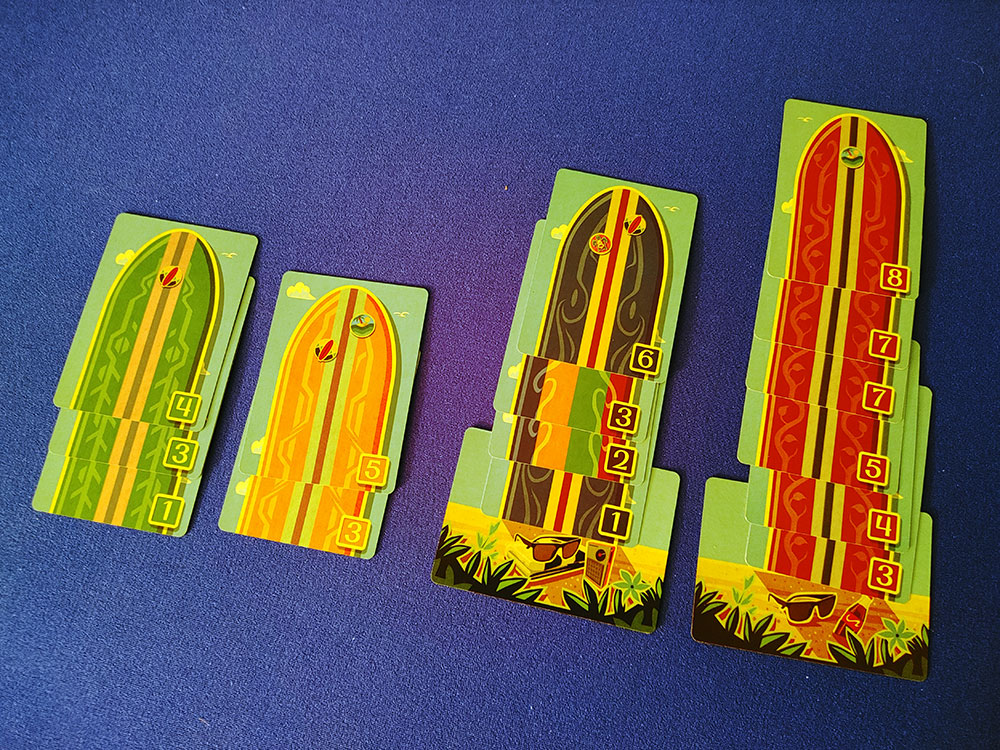
Game Experience:
Longboard feels exactly like a Reiner Knizia game should: there’s math and a closed currency (in this case the value of the cards in your play area) and a good deal of staring at your opponents’ play area while trying to figure out the best time to play for yourself or be vindictive. It’s all there. In a tiny little package that you can easily take on vacation or, well, to the beach. And yet: there simply isn’t much there…there.
Everything in the game works perfectly fine so I must believe that it’s designed as intended (with one possible exception, which I’ll expand upon later). The ladder climbing is satisfying as a base mechanism and the requirement that boards need to grow to a certain length to qualify for points is an acceptable complication. But the truth is that it never feels like any single player has any real control over anything that’s happening to or against them.
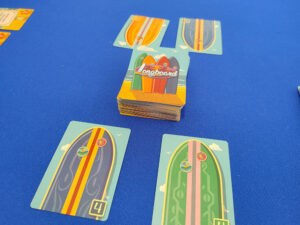
Being able to swap one’s cards with an opponent’s is fine in theory and you do get “currency” in return, but the game becomes a log-jam of attrition because no one really wants to add cards to their play area and then see a useful card be replaced by one that no one wants. In a way, it reminds me of the push-your-luck aspect that Ra forces on its players. Call an auction or wait it out and see what that clown across the table does on their turn? The difference is that Ra has a built-in timer that disrupts everyone’s plans and there’s no incentive to wait in this game (in Ra, calling the auction gives you some degree of leverage).
On top of this: all the game-end objectives are public knowledge so everyone is effectively trying to cash in on the same things. This creates market tension I suppose (“orange is the hot surfboard color this year!”) but also means that there’s nothing to direct an individual player in a different direction, which could have created alternate paths to points.
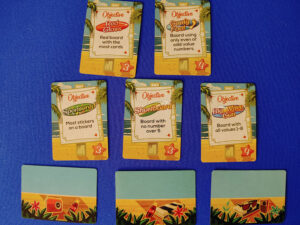
Earlier I mentioned that I feel there was a design flaw in this one and for my money the hidden information about how many stickers are on each covered board potion is ridiculous. Not only is this impossible to track even in a two-player game, but it also makes deciding when to end the game akin to flipping a coin. Even if a player has made an impressive collection of ladder-climbed boards, there’s no guarantee how many stickers are under there so the available information in front of the other players doesn’t really help one determine if it’s time to close down the beach and head inland to tally up surfer points.
Final Thoughts:
Listen: I was pretty disappointed with Longboard. It isn’t bad (I’m of the opinion that the good Dr. Knizia can’t make a truly bad game), but it definitely isn’t very good either. And, honestly, I don’t know if what players will get out of it makes it a worthwhile play. There are a ton of ladder-climbing games and many of them are significantly better than this one. (Just ask my boss Tony. Only when you do, be sure to ask him about “trick-taking games” since he still doesn’t know what ladder climbing is.)
Final score: 2.5 Stars. A fast-playing and incredibly swingy filler game that can’t quite replace other games in the genre.
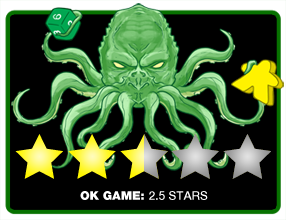 Hits:
Hits:
• Easy to play
• Easy to learn
Misses:
• Bad luck can derail the experience
• Turns feel samey after a while
• Uninspired objective cards
• Hidden information is too hidden






